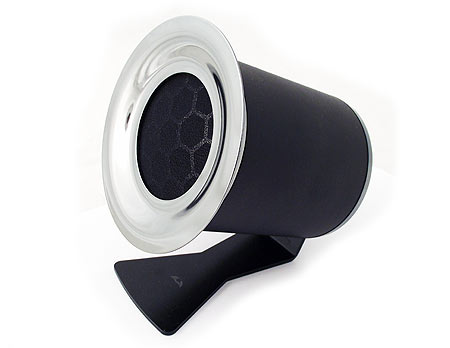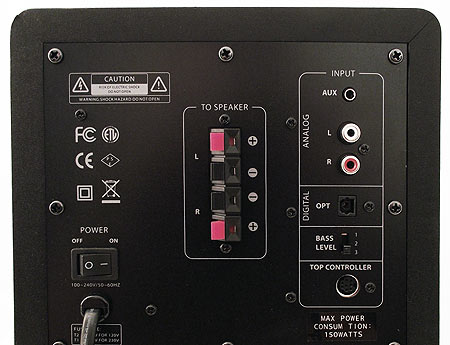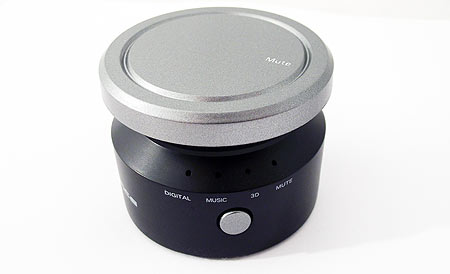Bringing Home The Bass: 2.1-Channel Speaker Roundup
Is it just us, or are 5.1- and 7.1-channel speaker systems impractical for PCs? In our 2.1 speaker roundup, we look at the Corsair SP2500 and Antec/Soundscience Rockus 3D|2.1, along with the Creative Gigaworks 3D, Klipsch Promedia 2.1, and Logitech Z623.
Soundscience Rockus 3D|2.1
You may not have heard of the Soundscience name, but if you have experience in the PC world, you’ve most likely heard of Antec. The company has been producing PC components like cases and power supplies since 1986, and Soundscience is Antec’s new subsidiary created to market audio- and video-enabled products. The brand’s flagship is the Rockus 3D|2.1, a speaker system that costs $249.99 at newegg.com and comes with a two-year warranty.
The Rockus 3D|2.1 differentiates itself visually from its competitors with a number of unique touches, such as the cylindrical anodized aluminum satellites and a tall and thin subwoofer. Each satellite measures 5.7" x 4.7" x 6.3" and contains a single 2.5” 25 W hemp driver, while the tall enclosure houses a 6” 100 W passive radiator subwoofer. At 13.8" x 7.7" x 10.2", the subwoofer enclosure is the tallest and thinnest in the roundup.
This product comes with a 1/8” mini-jack input cable and a stereo mini-to-RCA splitter cable. The satellite cables have an RCA-style jack on the speaker end and bare wires on the other for the output clips. There is also a remote control pod along with its dedicated cable.
All of the inputs are on the back of the subwoofer enclosure and consist of a 1/8” mini jack, a stereo RCA input, and a digital optical input. Yes, the Rockus 3D|2.1 has a digital input and is the only product in the roundup that can make that claim. Speaker systems with fewer than six channels that come equipped with a digital optical input are quite rare, although there are a few models with built-in sound hardware that use a USB interface. In any case, the Rockus 3D|2.1 sports an AKM AK5358B DAC, a higher-end component that can be found in respectable amplifiers like the Denon AVR-4311.
The control pod has one large volume knob that can execute a mute function when pressed like a button. There is a small button on the side of the remote that handles input selection (when held down) and toggles between music and 3D mode (when pressed and released quickly). These might not be the most intuitive controls, but they get the job done and are easy to get used to.
The music and 3D modes are for unmodified two-channel audio and virtual surround output, respectively. The Rockus 3D|2.1 uses a suite of DSP algorithms to create a virtual surround experience from two satellites and a subwoofer. We’ll talk more about this later in our tests.
Other than the control pod, there is a three-position bass level switch on the back of the subwoofer enclosure. I’m not a big fan of splitting control locations, especially when it’s on the back of something that isn’t particularly easy to access. But the thing that really concerns us about the control pod is the lack of headphone output for times when your roommate or family isn’t interested in sharing an explosive gaming or loud music experience. In our opinion, a headphone plug should not be optional on a high-end 2.1-channel PC speaker system.
Current page: Soundscience Rockus 3D|2.1
Prev Page Logitech Z623 Next Page Test Setup And BenchmarksGet Tom's Hardware's best news and in-depth reviews, straight to your inbox.
Don Woligroski was a former senior hardware editor for Tom's Hardware. He has covered a wide range of PC hardware topics, including CPUs, GPUs, system building, and emerging technologies.
-
clownbaby Wow, those freq response graphs are pretty telling that computer speakers are basically all trash. The bass peaks and generally crappiness in the mid range seem to be a common theme. Almost no consideration seems to be given to music listening.Reply
2.1 is the ideal setup for a computer imo. 4.1 at most. A center channel just isn't needed for monitor sized screens.
You can buy a cheap onkyo receiver, some low end bookshelf speakers and a small sub for a few hundred bucks and have sound that will destroy the best pc speakers.
The fact is, pc speakers are toys. There is no high end option. What they market as high end would be laughed out the door by the regular audio comminuty.
p.s. Plastic is not an acceptable cabinet material -
clownbaby this is what frequency response graphs of decent speakers should look like.Reply
http://www.speakerdesignworks.com/StatementCenterChannelResponsePlots.JPG -
clownbaby this is a frequency response graph of the first diy speaker I built from a popular design. This is a super budget MTM speaker.Reply
http://www.speakerdesignworks.com/TritrixMTMfr.gif -
d0gr0ck clownbabyWow, those freq response graphs are pretty telling that computer speakers are basically all trash. The bass peaks and generally crappiness in the mid range seem to be a common theme. Almost no consideration seems to be given to music listening.2.1 is the ideal setup for a computer imo. 4.1 at most. A center channel just isn't needed for monitor sized screens.You can buy a cheap onkyo receiver, some low end bookshelf speakers and a small sub for a few hundred bucks and have sound that will destroy the best pc speakers. The fact is, pc speakers are toys. There is no high end option. What they market as high end would be laughed out the door by the regular audio comminuty.p.s. Plastic is not an acceptable cabinet materialReply
Pretty much this. I've been telling people for ages that their super-duper PC speakers aren't. Any brand that quotes max power over RMS values raises an instant red flag for me. Even 20yr old Radioshack shelf speakers can run circles on most modern PC speakers.
I die a little bit every time I hear someone with a premium add-in sound card is running generic PC speakers.
-
tigsounds This is all Go out and buy it junk. Build your own and end up with something that rattles the neighbors nerves if done right.Reply -
Mark Heath For all those who trash all PC speakers, they're usually the best option on the lower end of the scale. There are people out there who have compared entry level (sub 400) active speakers to the Klipsch Promedia set (best active speakers ~150 for sound quality imo) and they say that they're not that different. If you do it right, then it's not as bad as you might think.Reply



